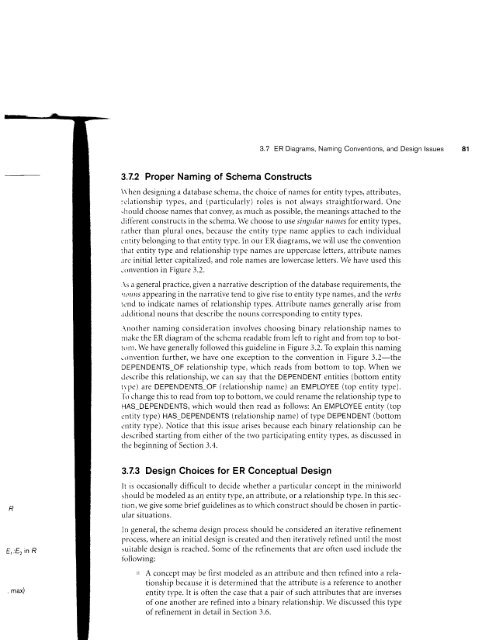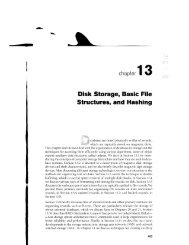this pdf excerpt
this pdf excerpt
this pdf excerpt
Create successful ePaper yourself
Turn your PDF publications into a flip-book with our unique Google optimized e-Paper software.
Ll,L2<br />
rrilr<br />
3.7.2 Proper Naming of Schema Constructs<br />
3.7 ER Diagrams, Naming Conventions, and Design lssues<br />
\r'hen designing a database scherna, the choice of names for entity types, attributes,<br />
:clationship types, and (particularly) roles is not always straightforrvard. One<br />
.hould choose names that convey, as rruch as possible, the meanings attached to the<br />
Jif tbrent constructs in the schema. We choose to use slngulc r names for errtity types,<br />
r.rther than plural ones, because the entity type name applies to each individual<br />
dutity belonging to that entity type. In our ER diagrarns, rve rvill use the convention<br />
that entity type and relationship type names are uppercase letters, attribute names<br />
.rr.- initial letter capitalized, and role names are lowercase letters. We have used <strong>this</strong><br />
;onvention in Figure 3.2.<br />
.\s a general prractice, giver.r a narratir,e description of the dirtabase requirements, the<br />
'l()lrll-s appearing in the narrative tend to give rise to entity type names, and the verbs<br />
l!'nd to indicate names of relationship types. Attribute names generally arrise from<br />
.rdclitional nor.rns that describe the nouns corresponding to entity types.<br />
.\nother nalning consicleration involves choosing binary relationship names to<br />
nr;rke the ER diagram of the schema readable fiom left to right and from top to bottrrrrr.<br />
We have generally follorved <strong>this</strong> gLrideline in Figure 3.2.To explain <strong>this</strong> naming<br />
.onvention further, we have one exception to the conventiorr in Fieure 3.2-the<br />
DEPENDENTS_OF relationship type, which reads from bottom to top. When we<br />
.lescribe <strong>this</strong> relationship, we can say that the DEPENDENT entities (bottom entity<br />
tvpe) are DEPENDENTS_OF (relationship name) an EMPLOYEE (top entity type).<br />
'fo<br />
cl.rarnge <strong>this</strong> to read from tol-r to bottc'rm, we coulcl rename the relationship type to<br />
HAS_DEPENDENTS, which would tl-ren read as fbllows: An EMPLOYEE entity (top<br />
.'ntity type) HAS_DEPENDENTS (relationship nnme) of type DEPENDENT (bottom<br />
..ntity type). Notice that <strong>this</strong> issue arises because each binar,v relationship can be<br />
.lcscribed starting from either of the trvo participating entitv types, as discussed in<br />
the beginning of Section 3.4.<br />
3.7.3 Design Choices for ER Conceptual Design<br />
It is occasiorlally difficult to decide rvhether a particular concept in the miniworld<br />
be modeled as an entity type, an attribute, or a relationship type. In <strong>this</strong> sec-<br />
'hould<br />
tion, we give some brief guidelines as to which construct should be chosen in particular<br />
situations.<br />
In general, the schema design process should be considered an iterative refinement<br />
process, where an initial design is created ar-rd then iteratively refined until the most<br />
suitable design is reached. Some of the refinements that are otten used irtclude the<br />
fbllowing:<br />
,.,, A concept may be flrst modeled as an attribute and then refined into a relationship<br />
because it is determined that the attribute is a reference to another<br />
entity t1'pe. It is often the case that a pair of such attrit'rr.rtes that are ir.rverses<br />
of one another are refined into a binarv relationship. We discussed <strong>this</strong> type<br />
of refinement in detail in Section 3.6.<br />
81














